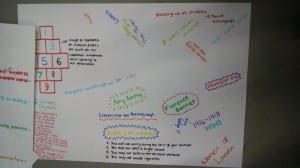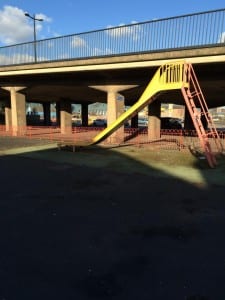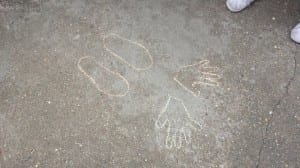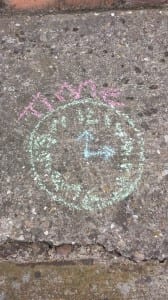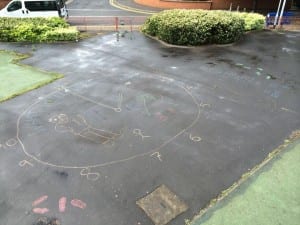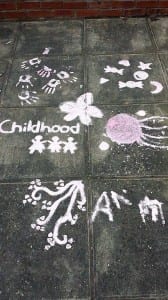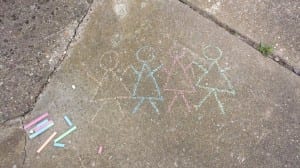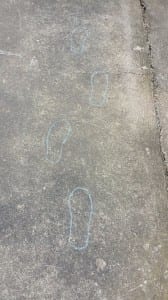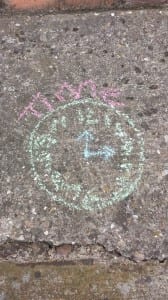Framing Statement
Our task was to create an audio based performance to go alongside our journey around the City of Lincoln. As a group, we chose The Museum of Lincolnshire Life as we felt that it would be a great basis for our site specific piece as we had an idea of wanting to base it on something to do with the topic of war. Our piece was titled Women of War, performed on the 7th of May 2015. We decided to base our piece on women in Lincoln during the First World War. As we were an all girl group, we thought that this was a good topic to choose, as it was also from a women’s perspective. We knew that as a group, we couldn’t replicate the First World War, as this was not possible; we therefore decided that we wanted to set the piece in the present time period, but with the feeling of memory being present in our audio track, providing a ‘ghostly’ feel to the piece, almost as though you are walking, whilst in their presence. The route of our piece began at the bench outside of Slug and Lettuce, which then involved an old fashioned sweet shop along the way, Steep-Hill then onwards towards the Museum. As our site piece was set out as a journey around the city of Lincoln, we felt that we should include Steep-Hill on the way to our site, as when people think of Lincoln, we thought that Steep-Hill would be something that they would associate Lincoln with. Also, Steep-Hill was part of the journey Florence Bonnett (we created a monologue for her story), took on her way to work, to go and work in the William Foster Factory, where she made the tracks for tanks.
With our piece being heavily audio based, we had to learn how to work with the software Audacity. I feel that the software was challenging to use at times, but I enjoyed working with it. We came to realise that our piece was in fact more tailor-made to represent a site generic performance, more than a site specific performance. Our piece was more site generic as we could actually perform it anywhere else in the City of Lincoln. Of course a site specific performance is based on a particular site, for example a room or a building. I feel that it was a shame that our piece wasn’t based mainly on a site; however I feel that it made us realise how we could improve our piece in the future if we were to do it again. Audience interaction with our piece was quite limited, with around 2 people at a time, because of the rainy weather. We had to improvise and change certain parts of the piece on the day, as they weren’t going to work because of the weather. An example of this was mine and Hannah’s part in the piece, as the rain stopped us from flying our paper aeroplanes properly and being able to carry out the performative actions in the correct manner; so we had to go to the next location of our piece sooner than we originally planned.
Performance Analysis
Our Drift to the ‘Museum of Lincolnshire Life’ was interesting and enjoyable. The particular topic which caught our attention was the treatment of Women during the Victorian Era and the war. We came across a classroom, which was very small and basic. Women teachers would have set rules in which they had to obey, one in which being that ‘they could not marry during the terms of their contract’ which is very strict and is something that doesn’t happen now, it sounds quite odd to hear. I wonder how women would react today, if these rules came back. The museum had many points of interest, such as letters, nursery rhymes that would be sung and games that were played. We felt that maybe we could incorporate some of these aspects into our performance. Overall it was a great experience. We all very much looked forward to creating our piece as a group and couldn’t wait to get started.
As a group, we decided to take a look at Punchdrunk. Punchdrunk inspired us because of their piece The Borough (2013) as they used audio in their piece and took their audience on a ‘theatrical journey’ (Punchdrunk,2013). This piece therefore links to our piece because we were taking our audience on a journey, around the city of Lincoln.
Whilst researching, I read Mike Pearson’s Introduction, where I came across the quote: ‘Site-Specific performance can be especially powerful as a vehicle for remembering and forming a community for at least two reasons. First, its location can work as a potent mnemonic trigger, helping to evoke specific past times related to the place and time of performance and facilitating a negotiation between the meanings of those times (ibid.,p.42).’ (Pearson,M.2010). From reading this quote, I thought that it related to our performance, as we are trying to evoke emotions, by using the monologues, to help portray the memory of these women’s lives.
From reading Fiona Wilkie’s Mapping The Terrain: a Survey Of Site-Specific Performance in Britain, Wilkie writes ‘Who is producing site-specific performance in Britain? Who see’s it? Where do these performances occur, or more particularly, ‘take place’? (Wilkie,2002). From this quote, I feel that myself and my group felt as though the Museum of Lincolnshire Life was our Site, as the audience, at the end of the piece could go and learn more about how the war impacted Lincoln in the museum. They couldn’t go into another museum and learn about how the war changed lives in Lincoln.
Dreamthinkspeak also inspired us from looking at their previous performance of Don’t Look Back (2003-2008). Dreamthinkspeak use different types of audio in their pieces; this is quite like our performance as we used our audio, but we layered it and used sound effects from freesound.org, it was quite like a soundscape, but with monologues included.
After researching what penny sweets children would eat during the war, liquorice appeared the most popular. Gobstoppers and ‘bulls-eyes’ also seemed a great buy for the children, using their pocket money. For our piece, we thought about including the sweet shop located near Steep-Hill, as we wanted to ask our audience into the shop and buy the liquorice. This was a way we wanted to keep the audiences attention, and was also a type of audience interaction we used in our piece. (BBC,2015).
Researching war time songs, ‘We’ll Meet Again’, was a popular song from the time. Other war time songs include: ‘The White Cliffs of Dover’, ‘Run Rabbit Run’ ‘Don’t Sit under the Apple Tree’.(Classics Website, 2015). And so on. I felt that we could use sections from these songs in our performance, when moving on to the next scene perhaps. I felt that if we used songs that were played during the war, it would make the audience feel part of the performance and it could have also created further imagery in their minds about the time period. We later on in the process, decided to not choose any war time songs as we where having trouble finding a way to do it without breaching any copyright laws. Instead we picked a couple of war time poems.
During our process, in one particular seminar session, when we were looking at performance in terms of framing and threshold, I felt, it was a different and interesting way of looking at the performance as a whole. The repetitive actions such as opening the door and saying ‘Hello’ over and over again, showed that in ordinary day situations, a greeting in which we say so naturally, can be turned into something that almost becomes robotic, as it was the same word being said at us, the meaning of the word felt like it was being lost in the process and we couldn’t do anything about it, we had to wait. During the exercise at first, we as an audience, didn’t know whether we should interact and say ‘Hello’ back to make it stop, however we tried saying ‘Hello’ back and it kept going, although us saying Hello back didn’t make it stop, I feel it was good that we all decided to try something as a group. For example my group needed to try things out a few times to see if they worked, such as the ‘wave goodbye’.
When thinking about our performance in terms of framing, I felt that we wanted a linear structure to it, but to also to make it interesting for the audience. We thought about the idea of using music from the war period, for our transitions, (from monologue to monologue) for example. For our performance, we wanted it to make sense for the audience members. We also said that the use of headphones was an example of a threshold for the audience, because it’s their way of entering the performance but in a different way. It was also discussed that The City of Lincoln could be an example of framing for our piece.
When researching what the words ‘Ethnographer’ and ‘Phenomenologist’, I found that an Ethnographer is when someone ‘deals with the description of specific human cultures, using methods such as close observation and interviews’. (Free Dictionary.com,2011) ‘Phenomenologist’ comes from the term ‘Phenomenology’ which means: ‘the study of structures of consciousness, as experienced from the first person point of view’. (Stanford Encyclopedia of Philosophy,2003).
After quite a few Audacity sessions, I felt that I gained a better understanding of the software and I really enjoyed looking for sound effects to go with our performance too. Throughout the process we came up with an introduction for the performance and researched Women during 1915 and how women had to work when the men went away to war. Also our aim was to portray how women, before the war, had their ‘traditional roles’ like cleaning the house and having children etc., and how from the women’s perspective was ‘not enough’, and how they felt like they were being patronized. When the women then went to work during the war, they finally had a voice and could do something other than their usual daily routine. Using symbolic movements in our performance we felt would be a nice way of audience interaction. The theme of ‘Working Women during the war’ is what we based the performance on. For symbolism in our performance we were thinking of getting our audience to use rubber bands and linking them together to represent the tracks of a tank for example, however we did not include this in the final piece. We learnt that minimal, but small symbolic movements, can have more of an impact on the audience. We also researched women’s narratives during the war, to see what their views where like.
To start writing our monologues, we had to decide on what tense we wanted to use, so they would fit with our piece. We chose to write them in the present tense from the characters perspective. For the piece, we decided to base them on: Amy Beechey, Florence Bonnett and the point of view of a Teacher. We went with the idea that all of these women connected with one another, as the war affected each of their lives, and how everything changed for them. We then edited our monologues to make sure that there weren’t any mistakes or things that didn’t sound right. After this we recorded two of the monologues, Amy Beechey and Florence Bonnett. We feel that we needed to make more changes to the Teacher piece. Having recorded our monologues, we uploaded them to Audacity and saved them to my drive account. As a group, we then planned to go to the Lincolnshire Archive to see the Letters that Amy Beechey received off her sons; as we wanted to include more in our monologues and to also make sure that we were using correct information. We also wanted to find out more information on Florence Bonnett and her fiancé who went to war. After being at the Archive for a few hours, we found some useful information for our piece. I feel that the trip to the Archive was interesting. During the visit, we looked through some of the letters which the archive had saved on a selection of discs that we then put into the computer. I found this particularly interesting as we not only found out more about the letters, we also found out about the use of censorship during the war. A main point of the visit which really interested me was the Beechey Boys letters to their mother, Amy Beechey. The army used post cards which told the soldiers what they could and couldn’t write, they also had to cross out anything that the soldiers had written that they didn’t want people to know. I couldn’t believe how secretive it all was, as I had never heard of them being limited to what they could and couldn’t write. We also read the telegram that Amy Beechy received when her son, Barnard had died. It must have felt awful of course, but even more so that when she opened the envelope and saw that the writing was typed and not written in her sons handwriting, it must have broke her heart even more, because she would have had an idea of what she was about to read.
Figure 1 (Cooke,L.Women of War,2015)
On our trip to the site with Karen, we figured out what we could work on, to make our ideas more solid and suitable. We tested out different actions to see how we could make them relate to our performance, and explained our thoughts to Karen. An example of our actions was the ‘wave goodbye’, we wanted this to show that the journey could continue to the next point. We also used repetition with our actions in the classroom part of our piece. I felt that having this session was really helpful as it helped us get back on track with our process and gave us more ideas to think about. It was also a positive for us to have the opinion of another person and to see it from their point of view. We then went on to work on our audio using audacity, to see if our audio worked well with our site and that all the timings where correct.
Evaluation
For our final piece, we decided to use performative actions, the ‘wave’ and the ‘aeroplane movements’ frequently used throughout our piece; just as subtle hints to do with our audio. When we finished our audio track, it was a great moment for us, as we had all worked very hard on the audio as we wanted it to sound right and be interesting for the audience. We were pleased with the outcome.
From the monologue of Florence Bonnett, to the monologue of Amy Beechey, we feel that we tried our best to include as much information, attention to detail and energy in the performance as we possibly could. When we thought about using the chalkboards as a symbolic reference to the people that lost their lives during the war, we wrote down the names: ‘Bonnett, Beechey, Wetherall and Foster.’ Overall, I feel that our performance was a very different experience to what I thought it would be. The weather had varied during the day whilst we were practicing our piece, unfortunately when it came to our assessed piece, the wind was strong, and the rain was torrential. However this didn’t stop us as performers; we kept going and tried our best to still put on a good piece.
We originally had the idea of wiping the names away to represent the end of their lives, however with the rainy weather, this symbolic part of our performance became even more symbolic, (I felt), as the rain aided us in washing away the names on the chalk boards. It was quite emotional in a sense, as it created a more intense, sad atmosphere overall.
To improve our performance if we had to do it again, I think that we should choose a stable site, and create a piece that is Site Specific. I feel that it would be nice to work in a site, to see the contrast between how our performance would be in a site, and how different it would be compared to, what we now realise, was a site generic performance.
Word Count:2755
Works Cited:
-BBC website (2015) Schools World War One: What was family life like? [Online] Available from http://www.bbc.co.uk/schools/0/ww1/25415720 BBC Website [Accsessed 10/5/2015].
– Classics Online (2015) All Clear: Favourite Wartime Songs. [Online] Available from http://www.classicsonline.com/catalogue/product.aspx?pid=836389 [Accessed 9/2/15].
– Stanford Encyclopedia of Philosophy (2003-2013) Phenomenology. [Online] Available from:http://plato.stanford.edu/entries/phenomenology/ [accessed 18/2/15].
– The Free Dictionary by Farlex(2003-2015) Ethnographer. [Online] Available from: http://www.thefreedictionary.com/ethnographer [accessed 18/2/15].
-Punch Drunk (2013) The Borough. [Online] Available from:http://punchdrunk.com/#past-shows/column/3 [Accessed 13/5/15].
Wilkie,F. Mapping The Terrain: a Survey Of Site-Specific Performance in Britain. New Theatre Quarterly (2002) Cambridge University Press.
–Dreamthinkspeak (2003-2008) Don’t Look Back Dreamthinkspeak. [Online] Available from: http://dreamthinkspeak.com/productions [Accessed 13/5/15].
-Pearson,M: Site Specific Performance. (2010) Basingstoke. Palgrave Macmillan.
